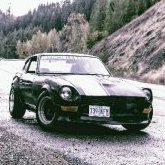Search the Community
Showing results for tags 'diy'.
-
If you're handy enough to install the $1500 Z power steering kit, you're probably handy enough to save $1400 and make your own. You need an Electric Power Steering Column from following vehicles which are manufactured by Koyo: Saturn Vue - from 2002 to 2007 Chevrolet Equinox - from 2005 to 2007 Saturn Ion - from 2003 to 2006 - only in steering column with metal ECU case. And this: http://www.ebay.com/itm/Saturn-Vue-Ion-Chevrolet-Equinox-Electric-power-steering-controller-box-EPAS-/182008071875?vxp=mtr (ebay seller: brunolopesantunes in case link goes dead) If you have an aftermarket ecm, megasquirt, etc with a vehicle speed sensor, you can even wire it in to adjust automatically to your settings at speed, if it will output variable resistance. Sorry, no pics. I have a million things to do to my Z before I worry about electric power steering. But there are plenty of other forums with write ups, and youtube videos demonstrating the concept. (disclosure: portions of text copied from http://forums.vintage-mustang.com/)
- 74 replies
-
- power steering
- electric power steering
-
(and 1 more)
Tagged with:
-
Did some digging around, and I'm going to get an adapter set made to adapt the 240z spindles to s550 disc brake mounting points. This are massive brakes that sell for pennies on the dollar. Good for the guys with 800 hp ls v8s and 2jz setups. Going to use 65 mustang hubs which have the same A2 and A6 inner and outer bearings as the 240z spindles. Still got some fitting to do, more to come later. We are talking 4 piston 14 inch brakes for under $200 sometimes. Or 15 inch monster 6 piston brembos setup if your heart desires. Anyways, let me know if anyone would be interested, I'll be building the setup for my own 240z, but if 5 or 6 people want some, I will make extras. I did something similar for 1968 dodge chargers and people love them. Made an adapter that allowed use of 2014 mustang brakes on drum hubs and people have been buying and using them with great results, so I'm not new to designing something that works and offering it to people. I'll post pictures as I make progress. Currently dealing with a child who has a fatal heart defect so this may take a few months, but this is something I'm seriously designing right now to go along with the super 8.8 rear irs conversion I'm developing... The idea is to have a balanced braking system off a 2015 mustang complete, front and rear, no mismatch.
-
Hello fellow datsunites. I'm looking for some insight on how your rb motors mount up. I'm looking to fabricate some mounts for mine but I wanna see how some of yours sit, even if it's a off the shelf kit. I just need them for reference and brain storming. What I have is a full square tube chassis car, I also have a fully built rb25. The motor was a previous 300zx swap so it came with the mounts. I plan on adapting those mounts to work with my application. I wanna set the motor back as far as possible, even if that means not mounting it to the cross member. I also wanna see how your pans hang in relation to the crossmember, any help is appreciated. I have searched for pictures or threads on this topic with no avail. I'm confident in my fabrication skills, I just wanna get some ideas and maybe we can all brainstorm. Thanks, Devin
-
With my seating position, my small-diameter fat-ring steering wheel is blocking my tach view right in the key areas. OK for DD but already at the first autox I had to keep hunching over and was undesireably encumbered. So I'm looking to make a shift light/indicator for my 72 240Z. Still in the concept stages and any suggestions/resources/corrections are greatly appreciated; I've found a surprising lack of any information of this kind. Im aiming at passive electronics, but may consider Arduino. I'm comfortable with either but mostly just would like to figure out how such a shift light indicator would work when fitted to distributor ignitions - ie what that signal looks like coming off the coil, or similarly even just how a tachometer works in that sense. So really the key is confirming that it is a 12V square wave with frequency reflecting that of all spark plugs firing. I have a multimeter but no data collection hardware at my house. I presume its 12V at the positive terminal where the tach connects. I have a 3 ohm coil, no ballast resistor. I have an electronic dizzy but thinking about it as points seems viable and simpler, so my thinking that I'd like to verify (please correct if wrong): voltage builds in coil when the contact is closed then releases into plug when it opens. so i would think there would be 12V at the input terminal when the contactor is closed and goes to zero when it fires - thus spark signal could be considered a falling edge triggered event. Although necessary to make sure I'm thinking correctly, that level of detail isn't really functionally necessary as all we need is frequency of this signal. I could just determine the RPM I would like the light to go off at, then correct to 'revolutions per second' then multiply by 3 (inline 6 = 3 ignitions per revolution) and we have target cutoff frequency to design circuit for. Right? I havent thought through the circuitry too much yet but generally seems like it would just be: high pass filter (tweaked to frequency) --> inverter --> light (?) Arduino may have the advantage of multiple RPM set points without having to reassemble the circuit. Then just use whatever kind of light - maybe even under the windshield vents as a HUD As I said any recommendation / correction / resouce is welcomed. Thanks in advance. Ben
-
Hi Guys, I'm still pretty new to the forum but I wanted to start contributing right away! I just bought a 1975 280z that had been sitting for over 10 years and was the victim of seized fuel injectors. There are a couple of options on how to handle the situation, one would be to replace the old injectors with new ones. Thats a solid choice but oem injectors will set you back $350+. Another option would be to buy refurbished injectors. Again, that's a fine option, but since fuel injectors are sealed units that cannot be opened, all you are really buying are old injectors that have been cleaned. Your next choice is to send the injectors off to a fuel injector cleaning service that specializes in cleaning electronic fuel injectors. If you choose that route I'd suggest www.witchhunter.com as they are a well known and good company. A full service cleaning is going to set you back about $180 but has the added benefit of having the injectors flow tested. Lastly, you have the option to clean them yourself. The process I came up with worked great for me and only cost about $20 and as such I will be discussing my method for the remainder of this article. Before we start, a disclaimer: *** The procedure Outlined below was developed by myself to clean my bosch L-jetronic fuel injectors. I am not a professional, nor do I claim to be. By performing any of the actions described in this article you risk damage to your fuel injectors that could render them inoperable. This process may be used on any injector however take special note of the correct voltage used to drive your specific fuel injectors.***** The Injector: How & Why Let's take a brief look at how the injector works and why it may end up seized shut. First things first, take a look at this cutaway view of an injector: (photo credit Gordon from witchhunter.com) The points we are most concerned with from this photo are numbered 4, 5, and 6. Number 4 is the coil. It is a coil of wire that wraps around the inside of the injector body. When current is sent through this coil, it creates and electromagnetic field, basically, it's an electromagnet. Number 5 is the pintle. Think of it as the rubber stopper that plugs the drain in your bathtub. It is a tiny piece of metal that for al intensive purposes "stops up" the fuel injector and keeps fuel from flowing through it. Numer 6 is the pintle seat. Think of this as the drain in your tub. It is the piece of metal with a hole in it that the pintle stops up. When the coil is energized, it becomes magnetized. This magnetic force pulls the pintle up away from the pintle seat allowing fuel to pass through the injector. When a car sits for a long time, the fuel in the injector degrades and separates releasing gums and varnish. As time passes and the fuel evaporates and degrades, whats's left is the gummy mess that clogs up the injector. When dry, it effectively "glues" the pintle the the pintle seat. Cleaning: Now that we know the basics of how an injector works and why they get clogged or seized, lets look at what we need to do to clean them. The basic strategy is the same whether clogged or seized but the approach is going to be a little bit different. The first thing we have to do is devise a way to pulse the injector out of the car. The next thing we will need to do will be to get the injector operable meaning we need to make sure the pintle is moving up off of its seat. This step won't be necessary if the injector is just clogged. Then we will want to do the actual cleaning, and finally we will replace the feed hoses and O-rings before reassembling the unit. Supplies Here is what you are going to need. 2 bottles of 91% isopropyl alcohol 1 small eye dropper 3 tupperware containers - 2 must be able to hold all 6 injectors and the cold start valve fully submersed in alcohol. The third needs to be slightly longer so that you can have good access to the injector while submerged. 2 lead wires with alligator clips electrical tape 6 to 8 D batteries Paper Towel (preferably shop towels) or a cloth Piece of cardboard or other suitable work surface Procedure: ​Now that you have all of your supplies it's time to get to work. Obviously the first thing you will need to do is remove the injectors from the motor. if you do not know how to do this I highly recommend you get yourself a factory service manual. There are also numerous how-to's online. Once you have everything together, find a comfortable place to work, I laid a piece of cardboard over the kitchen table and worked there but anywhere reasonable clean will do. Place all 7 injectors in one of the containers and fully submerse them in alcohol. Let them soak for about an hour, longer being better. Now take your other container and fill it with enough alcohol to submerse all 7 injectors (Don't forget your cold start valve!) and the other longer container with about 2 inches of alcohol. Place these to the side. the long one will be our working bath and the other one will be our clean bath for the injectors to continue to soak after we've worked on them. In order to clean the injectors, we must cycle them open and closed. To do this we will need to come up with a way to run a current through the injector. In our cars, the 12 volt current from the battery is routed through a dropping resistor that drops the voltage from 12v to 3.5v before it is passed through the fuel injector. So, ideally what we want is a 3.5v current that we can turn on and off to pass through the injectors. You could come with a whole bunch of different ways to do this depending on how fancy you wanted to get but my method is simple and easy and ver effective. If you did not know, a standard D battery output is 1.5v (actually AA, AAA, C, and D batteries all output 1.5v). By combining 2 D batteries in series ( + to -), the output voltage is bumped to 3v. This 3v current is very close to the 3.5v used in the vehicle so it will be perfect for replicating the pulse the injectors get in the car. So, what you will want to do is take two of your D batteries and tape them together so that the + side of one battery is touching the - side of the other. Now, grab your wires with the alligator clips and tape on end of one of the wires to the + one of your battery pack you just made. At this point you are ready to grab one of your injectors out of the alcohol bath and start disassembling and cleaning the exterior. Remove the bottom O-ring as well as the aluminum spacer on the main body. once the spacer is off you can remove the thin metal piece that sits right on top of it. Now you can work the thicker rubber O-ring off the main body of the injector and go to town cleaning. I used a toothbrush and some paper towel to get the outside decently clean. This isn't crucial but it will help to keep your cleaning bath free of contaminates. After you are happy with the cleanliness of the injector go ahead and attach the other end of the wire to one of the pins coming out of the injector plug. It doesn't matter which one since the magnetic field will be the same regardless of which direction the current is flowing. Go ahead and wrap the exposed metal of the alligator clip (if there is any) with some electrical tape to minimize the chances of the negative clip contacting it when she attach it. Speaking of the negative clip, go ahead and grab your other wire and attach one one to the other pin coming from the injector plug. What you should have now is as follows, -[ ]+-[ ]+ ----------Injector--------- in case mtg diagram doesn't make sense, you will have your two batteries taped together with one end of a wire taped to the positive side and the other end of that wire attached to one of the pins on the injector. From the other pin on the injector you should have another wire which is not currently attached to anything. Now if your car has been sitting for years, it is not uncommon for the injectors to be seized shut. If this is the case they will not open and will not spray any fuel. After all, that is the reason for this article. It is important that you remember that the injector is an electromagnet pulling the pintle off the seat with magnetic force. If the injector is seized then what that means, is that the magnetic force pulling up on the pintle is not great enough to overcome the force of the gunk holding the pintle down. So how can we free it up? First we need to see if that long soak in alcohol was enough to free it up. So go ahead and touch the free end of the cable coming off the injector to the negative end of your battery pack. It is good practice not to keep the current flowing throughout the injector for too long. If you hold it too long you can actually burn up the coil inside the injector and then you will have to replace it. Since we are only using 3V that isn't likely but better safe than sorry. If you are lucky, you will hear a click come from the injector meaning that the injector did actually open up. However, if you are like me, the injector will still be stuck. So what to do? Well, if you have ever taken physics then you may know what to do, but for those who haven't or are a bit rusty, heres a little physics lesson. Voltage is the potential difference across two points. Current is the rate at which the electric current flows. Resistance is the resistance to the flow of electricity. Voltage, current, and resistance are all directly related by the formula V = IR. V is voltage measured in volts, I is current measured in amps, and R is resistance measured in ohms. How does this apply to an injector? Well, the resistance of your injector is constant and does not change (unless you have a faulty injector that should be replaced) the variable that we can control here is the voltage that we send through the injector. By increasing the voltage, we are also increasing the current that the injector draws. That same formula above can be rewritten as I = V/R which mean that the current is equal to the voltage divided by the resistance. The resistance of an injector varies based on the application but lets assume here that our injectors resistance is 10 ohms. We just attempted to actuate the injector with a 3v pulse so let's calculate how much current that was. 3 volts divided by 10 ohms comes to 0.3 amps of current. Now, we know that 0.3 amps of current is not enough to break our injector free so how do we increase that? well, as we've learned we need to increase the voltage. to do this you need to simply tape one more battery in line with the other two making sure to put the + end of the battery to the - end of the other. this will increase the voltage by 1.5v for a total of 4.5v. This will bump our current to 0.45 amps. now try tapping the negative lead to the negative end of the battery and listen for a click. Tap it 5 or 10 times and if you still don't hear a click add another battery to the line and try again. Keep adding batteries one at the time until you get the injector to unstick. You can add up to 8 batteries in a row without risk of damaging the injector. The faster but less optimal way to do this would be to use a 12v car battery right from the get go to unstick the injector. this would be fine as long as you use short pulses of energy and do not hold leads on the battery for too long. At this point you should have gotten the injector to unstick and are ready to start cleaning it. If not, you will have to seek out another option for fixing your stuck injectors. The actual process of cleaning the injector is easier if you have a buddy to pulse the injector for you while you do the cleaning. So, assuming you do, have them start pulsing the injector while you force alcohol throughout he top with the eye dropper. do this for a few minutes and then do the same thing but this time forcing the alcohol though the nozzle end of the injector. During the process you should see dirty gunky fluid come out of the injector. repeat this until the fluid that comes out is clean and clear. Do note that it will only drip out and won't be any sort of stream of flowing. After you are done cleaning, place the injector in the clean alcohol bath until you are done with the remaining injectors. Repeat the above process for all 6 injectors including the cold start valve. The cold start valve was designed to run off of 7 to 12 volts so it may take a few batteries taped together before it will click open. Congratulations! You have successfully cleaned your injectors! Now we need to get the old hoses off and replace them as well as the O-rings. If your injectors are like mine, then you have hoses held on by small metal cups. I tried cutting the hose with a blade and pulling it off, but I could not for the life of me get the hoses off so I decided I would have to cut the metal cups. For this you'll ned a dremel and a razor blade along with a pair of pliers. This is the bit we will be grinding off. Before trying this, be sure to try and just pull off the hoses after you make a slit down the side with a blade. It may work for you and will save a big hassle! Hold the injector with the pliers and carefully start grinding away the metal cup. when you think you've ground off enough try and peel it away as best you can to expose the hose underneath. Now cut down the side of the hose to the base with the razor blade. Get your pliers and start pulling the hose off the injector. It will be really difficult but just keep twisting and pulling until you get it off. Once the hose is off, the cup will just slide right off. Replace the hoses with new fuel injection hose and clamps. Please be sure to use fuel injection hose and not normal fuel line. Now we can replace the O- rings and slide the thin metal piece and aluminum spacer back on. It helps to lube up the o-rings with a dab of motor oil! Now you are ready to reassemble everything and fire it up! If the motor has been sitting it would probably be a good idea to replace all the rubber fuel hose and clamps as well as the fuel filter and spark plugs! Thank you for checking out my writeup! I hope it helps you out!! -Blake
- 5 replies
-
- Fuel injector
- DIY
-
(and 7 more)
Tagged with:
-
I know there's lots of info out on the net about making your own driveshaft so I thought I'd organize my go to links here. Depending on what you've got for parts and what tools you've got available a DIY driveshaft might be a good option. This should be your freakin' BIBLE when doing any driveline work: Dana Spicer Installation Manual Here's some links below that give some torque ratings and dimensions of different joints and just interesting reading: http://www.fourwheeler.com/how-to/1006or-universal-joint-cv-joint-transferring-torgue/ http://www.driveshaftspecialist.com/HTML%20measure/UJ%20ID%20Guide.html http://mad4wd.com/blog/?p=18 http://www.wallaceracing.com/driveshaftspeed.htm http://www.rockcharger.com/tech/partnumbers.html http://www.pssupply.com/ratingsp.html http://www.drive-lines.com/dana/tranny_applications.php?model=Ford http://www.therangerstation.com/Magazine/summer2008/ujoints.htm And one of the most concise DIY builds: http://www.fordmuscleforums.com/transmission-articles/493751-how-shorten-your-driveshaft.html#post1556196 Everybody seems to do steel, but if you have a tig welder, well, why not do an aluminum one? They're on Trucks, Explorers, Aerostars etc. http://forums.vintage-mustang.com/4361425-post57.html And, if you have yoke problems, remember you can always take material off, but it's a bi*ch to put back on!
- 2 replies
-
- driveshaft
- weld
- (and 8 more)




